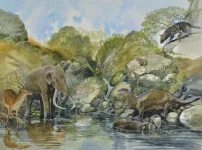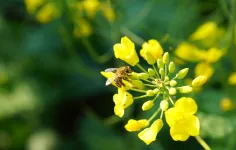(Press-News.org) Island dwarfs and giants are more susceptible to extinction than other species, particularly following the arrival of humans to their insular homes, according to a new analysis of island species over millions of years. The findings highlight the vulnerability of some of Earth’s most unique species and could be used to inform conservation strategies to preserve them. Although they cover less than 7% of the planet’s surface, islands are hotspots of biodiversity. Due to their isolation, islands often contain species that have led unique evolutionary trajectories resulting in peculiar features, including unusually large or small body sizes. For example, islands have hosted dwarf mammoths and giant rodents. However, islands are also known hotspots of extinction – particularly human-mediated extinction – with species that exhibit extreme body size shifts seemingly at greater risk.
To better understand the relationship between body size evolution and susceptibility to extinction, Roberto Rozzi and colleagues evaluated data on extinct and living island dwarf and giant mammal species and their risk and rate of extinction through time, both before and after human arrival. Rozzi et al. combined data on extinction risk, body mass, and body size change for 1231 extant and 350 extinct species of insular mammals from islands and paleo-islands worldwide spanning the last 23 million years. They found that extinctions and extinction risk were highest among island dwarf and giant species. Although the authors show that ongoing biodiversity loss observed on islands is part of an extended island extinction event that began more than 100,000 years ago, the Late Pleistocene/Holocene arrival of humans to distant islands, which began roughly 12,000 years ago, greatly accelerated its pace, increasing extinction rates by more than 10-fold. “Looking forward to the future, we recommend that conservation agendas give special priority to protecting insular giants and dwarfs – the surviving evolutionary marvels of island life,” write Rozzi et al.
END
Island dwarfs and giants are disproportionality prone to human-mediated extinctions
2023-03-09
ELSE PRESS RELEASES FROM THIS DATE:
Presenting a synapse-by-synapse map of an insect’s brain
2023-03-09
Researchers have presented the connectome – or synaptic wiring diagram – of an entire Drosophila larva brain. This first-ever insect whole-brain connectome is larger and more complex than previously reported connectomes and represents a valuable resource for future experimental and theoretical studies of neural circuits and brain function. The brain comprises complex networks of interconnected neurons that communicate through synapses. Understanding the brain’s network architecture is critical to understanding brain function. However, due to technological constraints, imaging entire brains with electron microscopy (EM) and reconstructing ...
The “MIDAS” platform detects protein-metabolite interactions
2023-03-09
To help improve the discovery and characterization of elusive interactions between proteins and metabolites, researchers present MIDAS (Mass spectrometry Integrated with equilibrium Dialysis for the discovery of Allostery Systematically). According to the authors, MIDAS represents a powerful new tool to “identify, understand, and exploit previously unknown modes of metabolic regulation across the protein-metabolite interactome.” The interactions between proteins and small-molecule metabolites are among the most common and fundamental types of biological interaction and play vital ...
Insular dwarfs and giants more likely to go extinct
2023-03-09
Leipzig/Halle. Islands are “laboratories of evolution” and home to animal species with many unique features, including dwarfs that evolved to very small sizes compared to their mainland relatives, and giants that evolved to large sizes. A team of researchers from the German Centre of Integrative Biodiversity Research (iDiv) and Martin Luther University Halle-Wittenberg (MLU) has now found that species that evolved to more extreme body sizes compared to their mainland relatives have a higher risk of extinction than those that evolved to less extreme sizes. Their study, which was published in Science, also shows that extinction rates of mammals ...
Honey bees use social learning to improve waggle dancing
2023-03-09
In a study published in Science, researchers from the Xishuangbanna Tropical Botanical Garden (XTBG) of the Chinese Academy of Sciences and the University of California San Diego have shown that honey bees use social signal learning to improve their ability to waggle dance.
Social learning shapes honey bee signaling, as it does communication in human infants, birds, and several other vertebrate species, according to the researchers.
Social learning occurs when one individual learns by observing or interacting with another. Eusocial insects (i.e., insects with an advanced level of social ...
Scientists call for global push to eliminate space junk
2023-03-09
Scientists have called for a legally-binding treaty to ensure Earth’s orbit isn’t irreparably harmed by the future expansion of the global space industry.
In the week that nearly 200 countries agreed to a treaty to protect the High Seas after a 20-year process, the experts believe society needs to take the lessons learned from one part of our planet to another.
The number of satellites in orbit is expected to increase from 9,000 today to over 60,000 by 2030, with estimates suggesting there ...
First wiring map of neurons in insect brain complete
2023-03-09
Researchers have built the first ever map showing every single neuron and how they’re wired together in the brain of the fruit fly larva.
This huge step forwards in science will ultimately help us understand the basic principles by which signals travel through the brain at the neural level and lead to behaviour and learning.
The map of the 3016 neurons that make up the larva’s brain and the detailed circuitry of neural pathways within it is known as a ‘connectome’. It’s the largest complete brain connectome described yet.
Professor Marta Zlatic ...
Large-scale study enables new insights into rare eye disorders
2023-03-09
Researchers have analysed image and genomic data from the UK Biobank to find insights into rare diseases of the human eye. These include retinal dystrophies – a group of inherited disorders affecting the retina – which are also the leading cause of blindness certification in working-age adults.
The retina is found at the back of the eye. It’s a layered tissue that receives light and converts it into a signal that can be interpreted by the brain. Each retinal layer comprises different cell types that play a unique role in this light conversion process.
For this study published in the journal PLOS Genetics, the researchers focused ...
University of Ottawa's Dr. Natasha Kekre wins national recognition for early career success in healthcare research
2023-03-09
Dr. Natasha Kekre is this year’s national winner of a “young investigator award” from the Canadian Society for Clinical Investigation (north_eastexternal linkCSCI), an organization that represents early career healthcare researchers across the country.
An exceptionally motivated scientist, Dr. Kekre is an associate professor at the uOttawa Faculty of Medicine, as well as a scientist and hematologist at The Ottawa Hospital.
Dr. Kekre says she’s been “very fortunate” to be in Ottawa’s dynamic medical research hub and benefit from having internationally ...
Nirogacestat, a new desmoid tumor treatment, improves outcomes for people with sarcoma
2023-03-09
A phase 3 clinical trial (research study) of a targeted therapy called nirogacestat has found that the drug significantly shrank desmoid tumors in 41% of patients.
Desmoid tumors (also known as aggressive fibromatosis) are a rare type of soft tissue tumor, and MSK has a team of doctors who are dedicated to treating them.
When Dana Avellino, now 36, first noticed a lump near her groin in the summer of 2018, she thought it was related her recent cesarean section. Her younger daughter was only 2 months old at the time. When a biopsy revealed that the lump was a sarcoma, a type of tumor that ...
Ringing an electronic wave: Elusive massive phason observed in a charge density wave
2023-03-09
Researchers at the University of Illinois Urbana-Champaign have detected the existence of a charge density wave of electrons that acquires mass as it interacts with the background lattice ions of the material over long distances.
This new research, led by assistant professor Fahad Mahmood (Physics, Materials Research Laboratory) and postdoc Soyeun Kim (current postdoc at Stanford Institute for Materials and Energy Sciences, SLAC National Accelerator Laboratory), is a direct measurement of the Anderson-Higgs mechanism (of mass acquisition) and the first known demonstration of a massive phason in a charge ...





